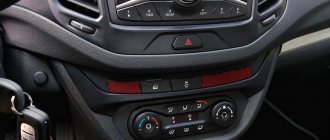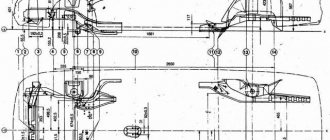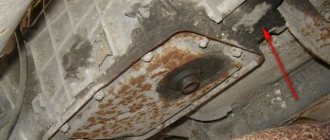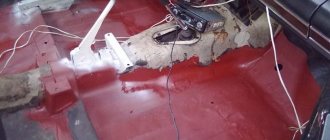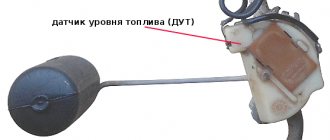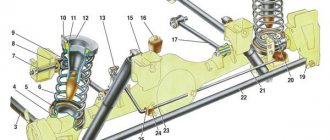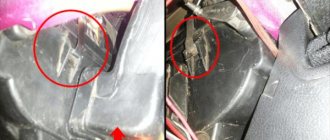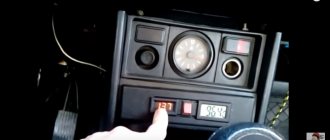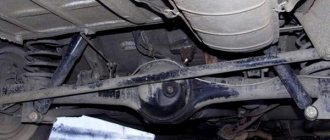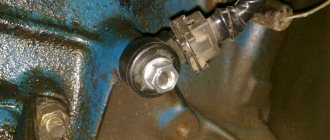Description of the VAZ 2106 body
The stamping method is considered almost the main reason for the slow aging of metal body elements. But many body panels of the “six” are made in this way. The elements are connected to each other using welding technology.
The frame of the VAZ 2106 is a combination of components:
- sub-engine frame;
- mudguards;
- floor elements;
- front and back parts;
- amplifiers;
- thresholds.
In fact, the body of the VAZ 2106 is a four-door sedan-type design with removable elements: doors, hood, trunk lid, fuel tank flap.
The “six” has chrome-plated bumpers, for beauty they are equipped with plastic sidewalls, and for protective purposes they are equipped with rubber bumpers. The car windows are polished as standard - the windshield is 3-layer, the rest are tempered, and the rear one is equipped with heating (not always).
The bottom has a molded carpet covering and is protected by a moisture-proof underlay. Sound and thermal insulation gaskets were found under it. The trunk floor is lined with special plastic.
The underbody of the VAZ 2106 has a molded carpet covering
The doors consist of two panels connected to each other using welding technology. The locks are equipped with locks; they are of the rotor type. The lock function is also provided on the hood, which has a cable drive - the opening handle is located in the cabin, under the driver's dashboard. The trunk lid has the same structure as the hood. Mastic-bitumen drier is the only corrosion protection (not counting the interior door trim) applied to the door panels. However, this composition during the Soviet era was of such high quality that it was sufficient in full.
Body dimensions
There is a concept of geometric and body dimensions. The first ones imply control points and distances, alignment of door and window openings, distance between axles, etc. As for body dimensions, these are the usual parameters:
- the body length of the “six” is 411 cm;
- width - 161 cm;
- height - 144 cm.
Standard body dimensions also imply the distance between the points of the front and rear axle. This value is called the wheelbase, and for the VAZ 2106 it is 242 cm.
Lada body diagram, opening sizes and clearances
Weight
“Six” weighs exactly 1 ton 45 kilograms. The main mass consists of the following parts:
- body;
- engine;
- rear axle;
- Transmission;
- shafts and other components.
Where is the body number located?
On the “six”, the main passport and technical data, including the body and engine numbers, are marked on identification plates. They can be found in several places:
- on the tide of the engine cylinder block to the left of the fuel pump;
- on the air supply box on the right;
- on the left rear wheel arch connector in the left front corner of the luggage compartment;
- inside the glove compartment.
Identification plate VAZ 2106 indicating the body and engine numbers
Read about the design of the VAZ 2106 fuel pump: https://bumper.guru/klassicheskie-modeli-vaz/toplivnaya-sistema/priznaki-neispravnosti-benzonasosa-vaz-2106.html
Additional body elements
In addition to the main elements of the body, it is customary to talk about additional components.
The side mirrors on the VAZ 2106 are designed to provide better visibility, thereby increasing the safety qualities of the car. However, in addition to their main function, mirrors also decorate the car. The design of mirrors adds completeness and class to the exterior, creating a unique style.
The “six” has simple side mirrors, not very large, like on foreign cars, but they provide the opportunity for tuning. They have an anti-dazzle surface and have a heating system that protects from moisture and snow.
Let's take a closer look at them.
- The right mirror is very limited in its adjustment capabilities, so the driver sees only the side of the car while driving.
- The left mirror is also not very modernized.
In addition to them, a rear view mirror is also provided. It is installed in the passenger compartment and contains a reflective surface with an anti-dazzle effect that protects the driver from dazzling. As a rule, the R-1a model is placed on the “six”.
Side mirrors are mounted on the doors. A rubber gasket is required to protect the body from damage. The element is fixed with 8 mm screws passed through the drilled holes.
Side mirrors of VAZ 2106 disassembled with gaskets
Linings also belong to additional body elements. They add aesthetics to the car. They are considered tuning parts, are installed on internal thresholds, and in addition to decorative functions, protect the paintwork.
Internal sill trim protects paintwork
Thanks to such thresholds, passengers' shoes do not slip when getting in or out of the car. In addition, there are models equipped with additional lighting.
The surface of the linings can be mirrored, corrugated, with an anti-slip effect, etc. The AvtoVAZ or Lada logo can be embossed on them.
VAZ 2106 car and its technical characteristics
The widely known VAZ-2106 car is the best-selling and very popular model, created on the basis of the Troika car (VAZ-2103). The production of the new model began in 1976 at the legendary Volzhsky Automobile Plant. The VAZ-2106 was a five-seater sedan (4 doors), equipped with a 4-speed gearbox, and often a 5-speed gearbox, and a powerful 1.6-liter carburetor engine. The VAZ-2106 car was mass produced until the beginning of 2002 at the giant Volzhsky Automobile Plant. The number of cars produced over all the years of production amounted to a significant figure - more than four million copies. In 1998, without reducing the volume of production of VAZ-2106 cars, production of the new VAZ-2110 model began (on the same conveyor). Four years later, the famous Izhevsk Automobile Plant began manufacturing cars of the VAZ-2106 model. The new model, unlike the previous version, used new comfortable seats from IZH-2126, as well as additional brake lights. Unfortunately, due to a significant decrease in consumer demand for VAZ-2106 cars, production of these once prestigious cars was discontinued at the Izhevsk Automobile Plant in 2006. During the entire production of the famous “Six”, almost 130 thousand units of VAZ-2106 cars were manufactured here. Unlike its predecessor VAZ-2103, the rear-wheel drive sedan VAZ-2106 received a much more modern appearance with an improved design: the radiator grille and bumper were significantly modified, updated headlight bezels made of high-quality plastic appeared, and high-quality license plate illumination was created , which was built into the rear headlight units. The interior of this car also differed very favorably from the usual VAZ-2103 interior: the new seats acquired a more attractive and comfortable textured appearance, headrests were added to the front seats, increasing comfort and safety, and the vehicle’s insulation from noise was significantly increased, which greatly pleased motorists. The appearance of the entire dashboard has also been significantly improved. It has changed for the better in its design, although all the instruments remain exactly the same in design as the previous model. Over the years, various modifications of the famous “Six” were produced. For example, the VAZ-2106 “Tourist” was manufactured by special order of the technical directorate as a pickup truck with a canvas tent, which was mounted into the body. The modification of the VAZ-21060 used an engine with a displacement of 1600 cubic centimeters. The VAZ-21061 used an engine from the Troika (VAZ-2103) with a volume of 1500 cubic centimeters. The VAZ-21062 modification (VAZ-2106 model) was intended for export, in which the steering wheel column was located on the right. VAZ-21063 cars were also produced, using engines from VAZ-21011 cars, which in turn appeared as a result of modifications of the legendary VAZ-2101 passenger cars. The working volume of these engines was about 1300 cubic centimeters. On those internal combustion engines, carburetors of the Ozone type 2105-11070-20 were used. The VAZ-21064 car was created on the basis of a modified VAZ-21061 car. It was well made and intended for export. The remarkable differences of the new car could not but please all knowledgeable car enthusiasts. The VAZ-21065 used an engine with a displacement of about 1500 cubic centimeters, a 5-speed gearbox, a higher power generator, and a SOLEX-21053 carburetor. All the bumpers of the new car were from the VAZ-2105, there was an electric heating of the rear window, a reliable contactless ignition system was used, the steering wheel had a safety design, the front doors were equipped with electric windows, a different (much more comfortable) type of seats was used, the front seats were equipped with headrests, the upholstery appears to be of higher quality. The VAZ-21065-01 car used an engine with a volume of 1500 cubic centimeters, a 5-speed gearbox, a generator of solid power, like the VAZ-21065 car, a Solex 21053 carburetor was used here, and the rear axle had a gearbox (3, 9). The car also had electric heating for the rear view glass, all front doors were equipped with fairly modern electric windows, and the ignition system was contactless. The VAZ-21066 car was a modification of the VAZ-21063 and was manufactured for export; accordingly, its steering wheel was located on the right. VAZ-21067 cars were the latest modifications of the Izhevsk VAZ-2106 car model (they were assigned an additional index). The VAZ-21067 was equipped with a fairly powerful engine from the VAZ-2106 with a volume of 1600 cubic centimeters. The engine of the modified VAZ-2106 had an improved fuel injection system and an additional catalyst that fully complied with all toxicity standards required by Euro 2. The VAZ-2106 car had very solid basic characteristics. It was designed for 5 seats, had a sedan-type body with the number of doors equal to 4. The car is capable of reaching a maximum speed of 150 km/h, accelerating to 100 km/h in 17.5 seconds. Fuel consumption on the highway is 8.2 liters; in the city -10.1 l; with a mixed version - 9.5 l. Engine capacity is 1569 cm3, fuel is gasoline, number of cylinders is 4, carburetor. The engine is located longitudinally at the front. Maximum power – 75 horsepower at 5400 rpm, torque up to 116 N*m. Rear-wheel drive. Length - 4166 mm, width of the car - 1611 mm, height - 1440 mm. The front track width is 1365 mm, the rear track is 1321 mm. The wheelbase is 2424 mm. The trunk volume is 345 l, the fuel tank volume is 39 l. Curb weight – 1035 kg, permissible – 1435 kg.
| Main characteristics | |
| Body type | sedan |
| Number of doors | 4 |
| Number of places | 5 |
| Performance indicators | |
| Maximum speed, km/h | 150 |
| Acceleration to 100 km/h, s | 17.5 |
| Fuel consumption (city / highway / mixed), l | 10.1 / 8.2 / 9.5 |
| Euro toxicity standard: | euro ii |
| Turning diameter, m: | No |
| Engine | |
| Engine volume, cm3 | 1569 |
| Fuel type | petrol |
| Number of cylinders | 4 |
| Cylinder arrangement | No |
| Engine power system | distributed injection |
| Engine location | front longitudinal |
| Number of valves per cylinder | 2 |
| Maximum power, hp/kW at rpm | 75 / 5400 |
| Maximum torque, N*m at rpm | 116 at 3200 |
| Transmission | |
| Gearbox type | mechanical |
| Number of gears | 4 |
| type of drive | rear |
| Dimensions | |
| Length, mm | 4166 |
| Width, mm | 1611 |
| Height, mm | 1440 |
| Ground clearance, mm | 170 |
| Front track width, mm | 1365 |
| Rear track width, mm | 1321 |
| Wheelbase, mm | 2424 |
| Trunk volume min/max, l | 345 |
| Fuel tank volume, l | 39 |
| Allowable weight, kg | 1435 |
| Curb weight, kg | 1035 |
| Own weight, kg: | No |
| Suspension | |
| Front suspension type | No |
| Rear suspension type | No |
| Front brakes | disk |
| Rear brakes | drums |
| Safety | |
| Driver airbag | No |
| Passenger airbag | No |
| Side airbags | No |
| Curtain airbags | No |
| Active head restraints | No |
| ABS | No |
| ESP | No |
| Xenon/Bixenon headlights | -/- |
| Comfort | |
| Power steering | No |
| Power windows front/rear | -/- |
| Electric mirrors/heated mirrors | -/- |
| Leather interior | No |
| Air conditioner | No |
| Climate control | No |
| Heated front seats | No |
| Height-adjustable driver's seat | No |
| Folding rear seat | No |
| Front armrest | No |
| Cruise control | No |
| Luke | No |
| On-board computer | No |
| Sports seats | No |
| Rain sensor | No |
| Parktronic | No |
| Leather trim of interior elements | No |
| Wood finishing (wood trim) of interior elements | No |
| Steering wheel remote control | No |
| Headlights corrector | Yes |
| Start button to start the engine | No |
| Music | |
| Standard audio preparation | No |
| Standard audio system with CD | No |
| Anti-theft protection | |
| central locking | No |
| Standard alarm | No |
| Standard immobilizer | No |
How to paint a VAZ 2106
As a rule, the owners of the “six” come to mind to paint the body in two cases: the paint coating has worn out or after an accident. First of all, attention is paid to the choice of paint - these days you can buy various options, but most often the car is painted with acrylic or metallic.
To find out what type of paint is applied to the car, just moisten a piece of rag in acetone, then apply it to an inconspicuous part of the body. If a trace of dye remains on the material, then it is an acrylic composition. Otherwise, the outer layer is varnish.
Before starting painting, it is recommended to carefully prepare the car. Here are the types of work preparation includes.
- Cleaning from dirt and dust.
- Dismantling elements that may interfere with the process.
- Straightening of defects: chips, scratches, dents.
- Acrylic primer.
- Treating the soil with abrasive paper.
Only after these steps can you begin the spray painting process. Apply 3 layers of paint. The first and third layers will be the thinnest, the second - the thickest. At the final stage of painting, varnish is applied.
As for the technology of applying metallic paint, the main coating here is a layer of varnish. Aluminum powder is added to it, which gives the effect of polished metal. The body should be coated with varnish in 2-3 layers using the same sprayer.
Painting the engine compartment with acrylic paint
